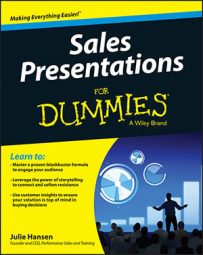How to memorize or read from a script is a topic rarely covered in sales meetings, yet the success of your sales presentation lies on your ability to effectively and accurately communicate your message. When it comes to using scripts, there are three basic methods to choose from. Some salespeople like to put their script in the notes section of PowerPoint or Keynote to read from or refer to as they present. Others prefer to memorize the entire script, whereas still others prefer to wing it and hope for the best.
What’s the best way to work with a script? The answer is it depends. Here are some pros, cons, and best practices for each style.
Employing the best practices for your method of choice helps ensure that you’re able to deliver your script in an authentic and engaging manner.
Using presenter notes
The notes section of your slides are a handy way to associate key points you want to make with the appropriate slide. Following are some pros and cons for using your presenter notes effectively in your presentation.
Pros: They’re right there in front of you when you need them. You don’t have to shuffle through papers or worry about blanking out. Even if you don’t end up referring to your notes, the act of typing them with the associated slide can provide mental reinforcement.
Cons: Presenter notes keep you stuck behind your laptop. Even if you know the material, you can easily start relying on your notes. Reading your notes, sounding authentic, and interacting with your audience at the same time is difficult. Unless you’re really good, your audience can see that you’re reading notes — or in a web presentation, hear it in your voice — and prospects feel less engaged.
Best practice: Use presenter notes to write down key phrases, numbers, or words that you need to get right. Don’t write down full sentences and don’t use notes for every slide, especially the ones that are obvious. When using your notes, follow a practice actors use: Glance at your notes, get the information you need, and then make eye contact with your prospect as you say them. Make a point of stepping away from the laptop for several slides at a time when don’t need your notes.
Memorizing
If you have the time and the ability to memorize comes easily to you, committing your presentation to memory is often the best way to free you up from the constraints of a script. Here are some additional reasons you may want to consider when memorizing your script as well as some tips that can keep your script sounding fresh and natural each time you deliver it.
Pros: Memorization gives you the benefit of having the information in your head when you need it and the freedom to improvise as you see fit — no fumbling for notes or staring at your laptop. You can focus on engaging and connecting with your audience.
Cons: Sometimes it’s not all there in your head. Nerves or distractions can cause you to forget what you were going to say. Few people know how to memorize a script in a way that makes recall easier and keeps their delivery sounding fresh and authentic.
Best practices: Because memory isn’t fail-proof, keep key points in your presenter notes as a fall back. The way you memorize your script can greatly affect your ability to recall it when needed and how you deliver it. Here are some good memorization tips used by actors:
Get familiar with your script before memorizing. Most salespeople jump straight to memorization, which can lock them into a mechanical delivery that sounds preplanned and insincere. Read through your script a number of times before attempting to memorize it. Get the big picture first and let memorization be a natural byproduct of that familiarity.
Know your subtext. Many salespeople try to memorize their script word for word and then get thrown off when they forget a specific word during their presentation. Focus on the subtext — the underlying meaning of each line. What are you really saying and why are you saying it? Knowing this information helps you to stay in the flow of your presentation and find your way back if you should get off track.
Don’t predetermine how to say it. Many presentation coaches tell you precisely which words to emphasize and where to pause or smile or gesture. This type of delivery rings false to most audiences and should be avoided at all costs. It reinforces a mechanical delivery that is tough to break. Just as a good actor doesn’t give the same performance night after night, your delivery will change based on what’s happening in the moment and your reaction to your prospect — both verbally and nonverbally — keeping your delivery fresh and exciting.
Winging it
Like to go with the flow in your presentation? Operating without a net isn’t without its drawbacks. Make sure you understand the risks and consider putting the following safety measures in place for when you do choose to venture off script.
Pros: You’re in the moment and able to react to your prospect.
Cons: You may forget to make certain points or leave out important details or entire sections. You may wander far off course and struggle to find your way back. You can appear unprepared and damage your credibility.
Best practice: Allow room to improvise in a well-rehearsed presentation, but leave the total improvisation to the pros. Know your material so well — or keep your presenter notes handy — to make sure that you hit all the important points and have a good sense of timing when you do go off script.

